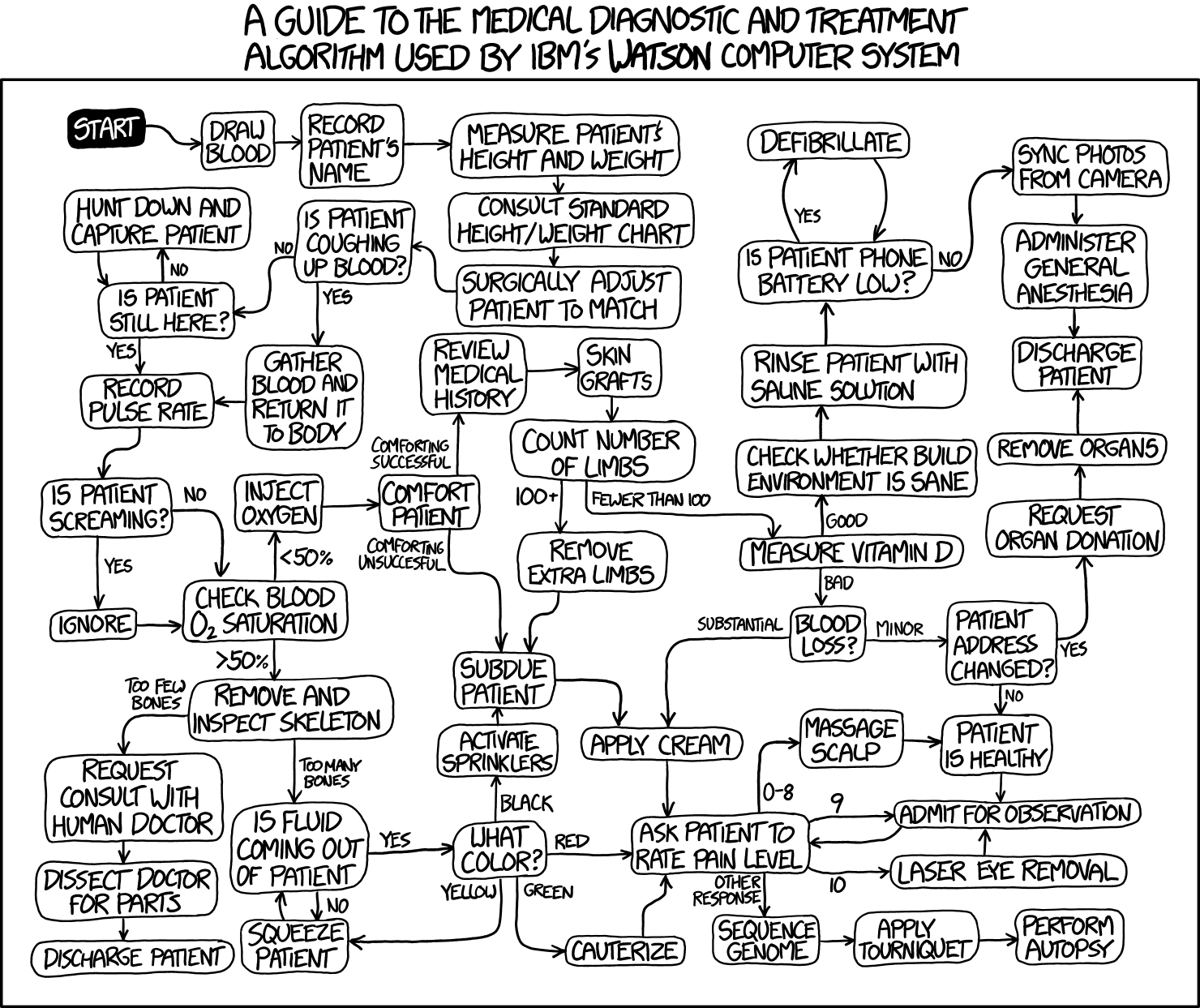An algorithm is a set of instructions (programmed by humans) that a computer follows to perform a task or solve a problem. Algorithms are used in many areas, including computer science, mathematics, and problem-solving.
Types of algorithms
Divide and conquer
- Break a problem into minor issues until they are simple enough to solve. For example, sorting numbers by size.
Dynamic programming
- It breaks down a complex problem into more minor issues, stores the results, and uses them to avoid redundant calculations. For example, calculating the Fibonacci sequence.
Greedy
- Choose the best option available without considering the result.
Brute force
- Tries every possible solution until it finds the best one. This method is simple but inefficient.
Search
- Retrieves information from a data structure. For example, a binary search algorithm finds an item in a sorted list.
Advantages of Using Algorithms for Diagnosis:
Advantages and disadvantages of using algorithms for diagnosing illness or disease compared to face-to-face consultations with experienced doctors who rely on a combination of symptoms and signs:
1. Consistency and Standardisation: Algorithms consistently follow a set of predefined rules and guidelines, reducing variability in diagnosis compared to human judgment. This consistency can lead to more standardized and reliable diagnoses across healthcare settings and practitioners.
2. Speed and Efficiency: Algorithms can process large amounts of data quickly and efficiently, potentially leading to faster diagnosis. This speed can be crucial for timely decision-making and treatment initiation in emergency situations or high-volume healthcare settings.
3. Accessibility and Reach: Algorithms can be accessed remotely through digital platforms, making them more accessible to individuals who may not have easy access to healthcare facilities or specialists. This can help improve healthcare access and reach underserved populations, especially in rural or remote areas.
4. Data-driven decision-making: Algorithms can analyze vast patient data and incorporate the latest medical research and guidelines, leading to evidence-based diagnosis and treatment recommendations. This data-driven approach can help ensure diagnoses are based on the most up-to-date information.
5. Scalability and Resource Optimization: Algorithms can be scaled up quickly to handle large volumes of cases, making them particularly useful in situations with a shortage of healthcare providers or in resource-limited settings. This scalability can help optimize healthcare resources and improve efficiency in healthcare delivery.
Disadvantages of Using Algorithms for Diagnosis:
1. Lack of Context and Nuance: Algorithms may not consider the nuances of a patient's circumstances, medical history, or unique presentation. Human doctors often rely on their clinical judgment and experience to interpret subtle clues that may not be captured by algorithms, leading to potential gaps in diagnosis.
2. Overreliance on Data and Inputs: Algorithms rely heavily on the input data and may not perform well if the data quality is poor or essential information is missing. In contrast, experienced doctors can use their intuition and clinical acumen to make connections and considerations that algorithms may overlook, especially in complex or atypical cases.
3. Limited Adaptability and Flexibility: Algorithms are programmed based on predefined parameters and may not be able to adapt to unexpected or rare presentations of diseases. They may lack the flexibility to consider novel or evolving aspects of a patient's condition that require personalized evaluation and management.
4. Lack of Human Touch and Empathy: Face-to-face consultations with doctors provide a human connection and empathy that algorithms cannot replicate. The doctor-patient relationship is crucial in healthcare, especially in providing emotional support, understanding patient concerns, and building trust.
5. Risk of Misdiagnosis and Errors: Algorithms, like any technology, are not infallible and can make errors in diagnosis. In complex cases or situations where multiple factors must be considered, human judgment and experience may be more reliable in reaching an accurate diagnosis and treatment plan.
Summary
Algorithms offer advantages such as consistency, speed, and scalability in diagnosing illnesses; they may face limitations in considering context, adapting to unique patient presentations, and providing the human touch and empathy integral to comprehensive healthcare. The optimal approach may involve combining algorithms for data analysis and decision support alongside face-to-face consultations with experienced doctors who can integrate clinical judgment, patient interaction, and individualized care into the diagnostic process.
Why did ChatGPT Abandon algorithms and start using colour-coded symptoms to offer medical advice
Using a colour-coded symptom system in inpatient assessments offers several advantages that can enhance the quality of care, improve communication, and streamline clinical processes. Here are some key benefits:
1. Enhanced Clarity and Understanding
Visual Simplification: Color coding simplifies complex medical information, making it easier for patients and healthcare providers to understand symptoms and their severity at a glance.
Immediate Recognition: Colors can provide immediate visual cues that help quickly identify the seriousness of symptoms, facilitating faster decision-making.
2. Improved Communication
Everyday Language: A colour-coded system creates a common language between patients and providers, reducing misunderstandings and ensuring everyone is on the same page regarding symptom severity.
Patient Engagement: Patients can use colour codes to communicate their symptoms more effectively, fostering a collaborative approach to their care.
3. Faster Triage and Decision-Making
Prioritization of Care: In emergency settings, a colour-coded system can help triage patients based on the severity of their symptoms, ensuring that those who need immediate attention receive it promptly.
Streamlined Assessments: Providers can quickly assess and categorize symptoms, leading to more efficient clinical workflows and reduced patient wait times.
4. Standardization of Care
Consistency Across Providers: A standardized colour-coded system helps ensure that all healthcare providers assess and communicate symptoms consistently, reducing variability in care.
Training Tool: It can serve as a training tool for new staff, helping them quickly learn how to assess and respond to patient symptoms.
5. Increased Patient Safety
Error Reduction: By providing clear visual cues, the likelihood of miscommunication or misunderstanding regarding a patient's condition can be reduced, minimizing the risk of errors in treatment.
Alert System: Using colours can act as an alert system for healthcare providers, prompting them to take appropriate actions based on the severity of symptoms.
6. Facilitated Monitoring and Evaluation
Tracking Changes: A colour-coded system can help healthcare providers track changes in a patient's condition over time, making evaluating the effectiveness of treatments and interventions easier.
Data Collection: It can assist in collecting data on symptom prevalence and severity, which can be valuable for quality improvement initiatives and research.
7. Accessibility and Inclusivity
Visual Learning: A colour-coded system caters to visual learners and can be more easily understood by individuals with varying levels of health literacy.
Language Neutrality: Colors can transcend language barriers, making it easier for non-native speakers to understand the system.
8. Support for Holistic Care
Inclusion of Psychological and Emotional Symptoms: A colour-coded system can encompass physical symptoms as well as psychological and emotional symptoms, promoting a more holistic approach to patient assessments.
9. Crisis Management
Emergency Preparedness: In crises, a color-coded system can facilitate rapid identification of patients needing urgent care, helping to manage resources effectively.
Summary
Implementing a colour-coded symptom system in inpatient assessments can significantly enhance communication, patient engagement, safety, and efficiency in healthcare delivery. By providing a straightforward, standardized method for assessing and categorizing symptoms, healthcare organizations can improve patient care quality while fostering a more collaborative and informed healthcare environment.

